Business Environment Report: Iceland Supermarket and Toyota
VerifiedAdded on 2019/12/28
|10
|2842
|183
Report
AI Summary
This report provides a comprehensive analysis of the business environment, focusing on two contrasting businesses: Iceland Supermarket and Toyota. It begins by describing different business types, including sole traders, partnerships, and private limited organizations, outlining their purposes and ownership structures. The report then examines the various stakeholders of Iceland Supermarket and explains how organizations can meet their objectives. It further delves into the organizational structures and functioning areas of the chosen businesses, highlighting the production, research and development, and purchasing functions. The report also explains how the organizational styles of these businesses help them fulfill their purposes. The analysis extends to the influence of contrasting economic environments on business activities, using examples from Toyota's operations in different regions. Finally, the report concludes with a discussion of political, legal, and social factors impacting the businesses and their stakeholders.
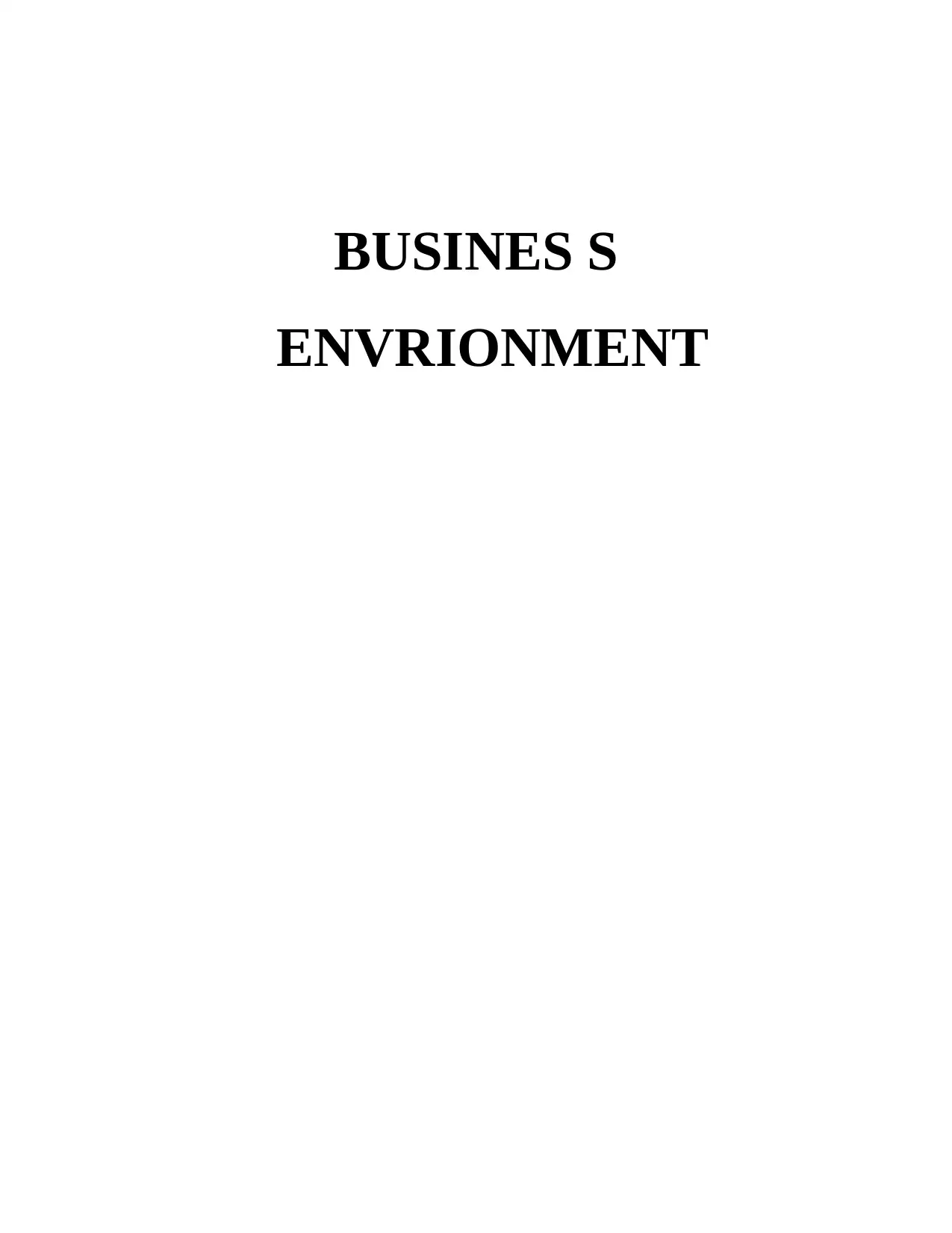
BUSINES S
ENVRIONMENT
ENVRIONMENT
Paraphrase This Document
Need a fresh take? Get an instant paraphrase of this document with our AI Paraphraser
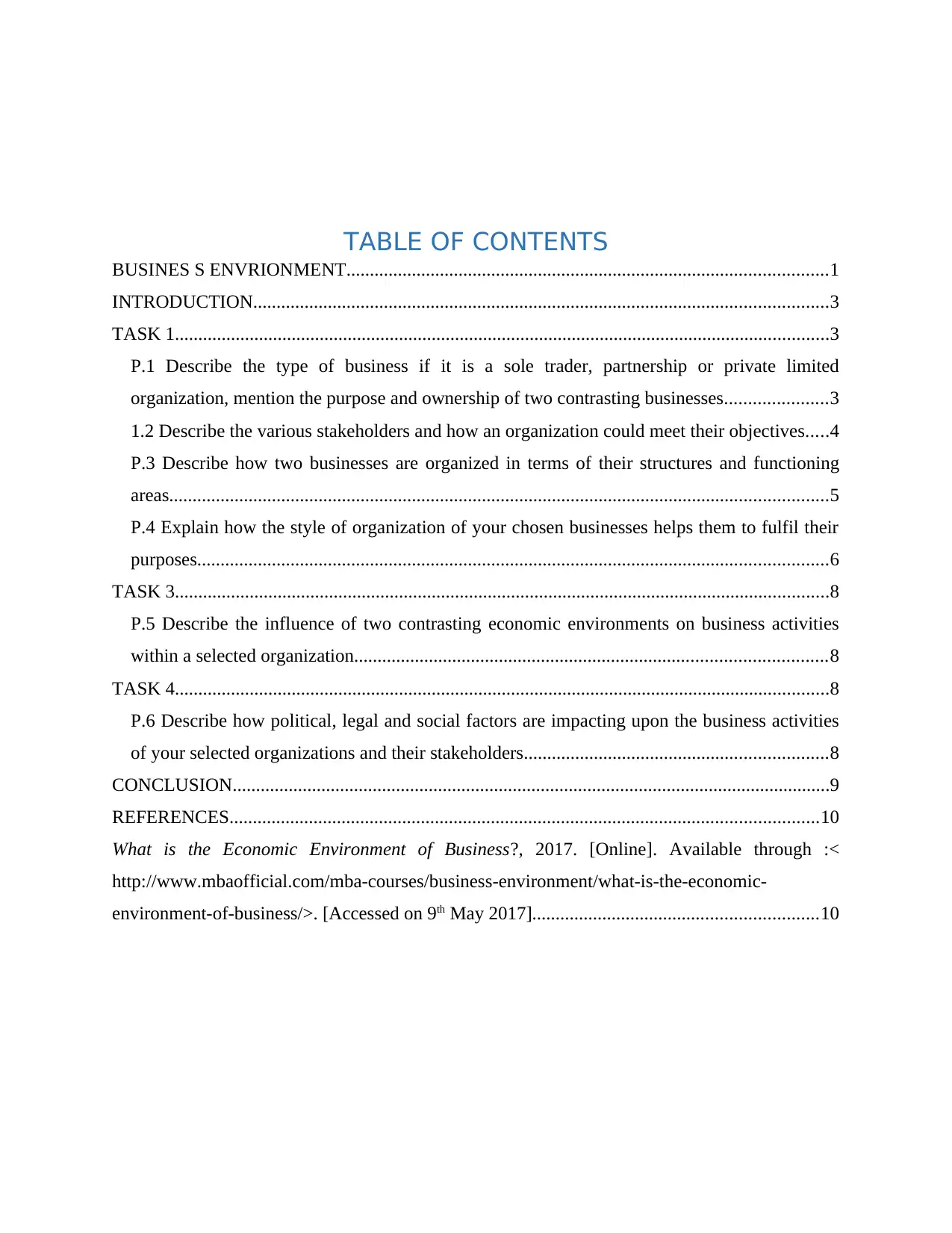
TABLE OF CONTENTS
BUSINES S ENVRIONMENT.......................................................................................................1
INTRODUCTION...........................................................................................................................3
TASK 1............................................................................................................................................3
P.1 Describe the type of business if it is a sole trader, partnership or private limited
organization, mention the purpose and ownership of two contrasting businesses......................3
1.2 Describe the various stakeholders and how an organization could meet their objectives.....4
P.3 Describe how two businesses are organized in terms of their structures and functioning
areas.............................................................................................................................................5
P.4 Explain how the style of organization of your chosen businesses helps them to fulfil their
purposes.......................................................................................................................................6
TASK 3............................................................................................................................................8
P.5 Describe the influence of two contrasting economic environments on business activities
within a selected organization.....................................................................................................8
TASK 4............................................................................................................................................8
P.6 Describe how political, legal and social factors are impacting upon the business activities
of your selected organizations and their stakeholders.................................................................8
CONCLUSION................................................................................................................................9
REFERENCES..............................................................................................................................10
What is the Economic Environment of Business?, 2017. [Online]. Available through :<
http://www.mbaofficial.com/mba-courses/business-environment/what-is-the-economic-
environment-of-business/>. [Accessed on 9th May 2017].............................................................10
BUSINES S ENVRIONMENT.......................................................................................................1
INTRODUCTION...........................................................................................................................3
TASK 1............................................................................................................................................3
P.1 Describe the type of business if it is a sole trader, partnership or private limited
organization, mention the purpose and ownership of two contrasting businesses......................3
1.2 Describe the various stakeholders and how an organization could meet their objectives.....4
P.3 Describe how two businesses are organized in terms of their structures and functioning
areas.............................................................................................................................................5
P.4 Explain how the style of organization of your chosen businesses helps them to fulfil their
purposes.......................................................................................................................................6
TASK 3............................................................................................................................................8
P.5 Describe the influence of two contrasting economic environments on business activities
within a selected organization.....................................................................................................8
TASK 4............................................................................................................................................8
P.6 Describe how political, legal and social factors are impacting upon the business activities
of your selected organizations and their stakeholders.................................................................8
CONCLUSION................................................................................................................................9
REFERENCES..............................................................................................................................10
What is the Economic Environment of Business?, 2017. [Online]. Available through :<
http://www.mbaofficial.com/mba-courses/business-environment/what-is-the-economic-
environment-of-business/>. [Accessed on 9th May 2017].............................................................10
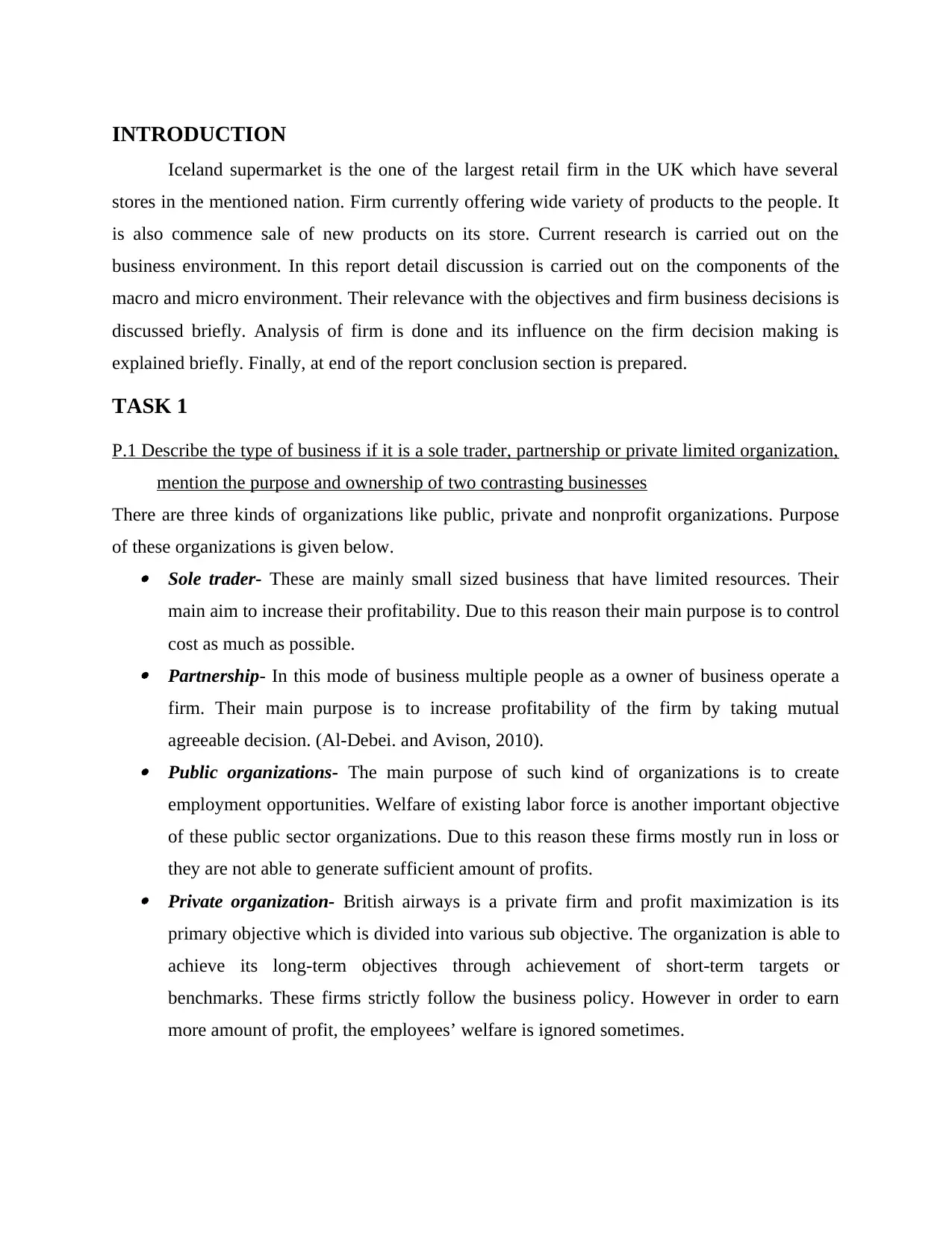
INTRODUCTION
Iceland supermarket is the one of the largest retail firm in the UK which have several
stores in the mentioned nation. Firm currently offering wide variety of products to the people. It
is also commence sale of new products on its store. Current research is carried out on the
business environment. In this report detail discussion is carried out on the components of the
macro and micro environment. Their relevance with the objectives and firm business decisions is
discussed briefly. Analysis of firm is done and its influence on the firm decision making is
explained briefly. Finally, at end of the report conclusion section is prepared.
TASK 1
P.1 Describe the type of business if it is a sole trader, partnership or private limited organization,
mention the purpose and ownership of two contrasting businesses
There are three kinds of organizations like public, private and nonprofit organizations. Purpose
of these organizations is given below. Sole trader- These are mainly small sized business that have limited resources. Their
main aim to increase their profitability. Due to this reason their main purpose is to control
cost as much as possible. Partnership- In this mode of business multiple people as a owner of business operate a
firm. Their main purpose is to increase profitability of the firm by taking mutual
agreeable decision. (Al-Debei. and Avison, 2010). Public organizations- The main purpose of such kind of organizations is to create
employment opportunities. Welfare of existing labor force is another important objective
of these public sector organizations. Due to this reason these firms mostly run in loss or
they are not able to generate sufficient amount of profits. Private organization- British airways is a private firm and profit maximization is its
primary objective which is divided into various sub objective. The organization is able to
achieve its long-term objectives through achievement of short-term targets or
benchmarks. These firms strictly follow the business policy. However in order to earn
more amount of profit, the employees’ welfare is ignored sometimes.
Iceland supermarket is the one of the largest retail firm in the UK which have several
stores in the mentioned nation. Firm currently offering wide variety of products to the people. It
is also commence sale of new products on its store. Current research is carried out on the
business environment. In this report detail discussion is carried out on the components of the
macro and micro environment. Their relevance with the objectives and firm business decisions is
discussed briefly. Analysis of firm is done and its influence on the firm decision making is
explained briefly. Finally, at end of the report conclusion section is prepared.
TASK 1
P.1 Describe the type of business if it is a sole trader, partnership or private limited organization,
mention the purpose and ownership of two contrasting businesses
There are three kinds of organizations like public, private and nonprofit organizations. Purpose
of these organizations is given below. Sole trader- These are mainly small sized business that have limited resources. Their
main aim to increase their profitability. Due to this reason their main purpose is to control
cost as much as possible. Partnership- In this mode of business multiple people as a owner of business operate a
firm. Their main purpose is to increase profitability of the firm by taking mutual
agreeable decision. (Al-Debei. and Avison, 2010). Public organizations- The main purpose of such kind of organizations is to create
employment opportunities. Welfare of existing labor force is another important objective
of these public sector organizations. Due to this reason these firms mostly run in loss or
they are not able to generate sufficient amount of profits. Private organization- British airways is a private firm and profit maximization is its
primary objective which is divided into various sub objective. The organization is able to
achieve its long-term objectives through achievement of short-term targets or
benchmarks. These firms strictly follow the business policy. However in order to earn
more amount of profit, the employees’ welfare is ignored sometimes.
⊘ This is a preview!⊘
Do you want full access?
Subscribe today to unlock all pages.

Trusted by 1+ million students worldwide
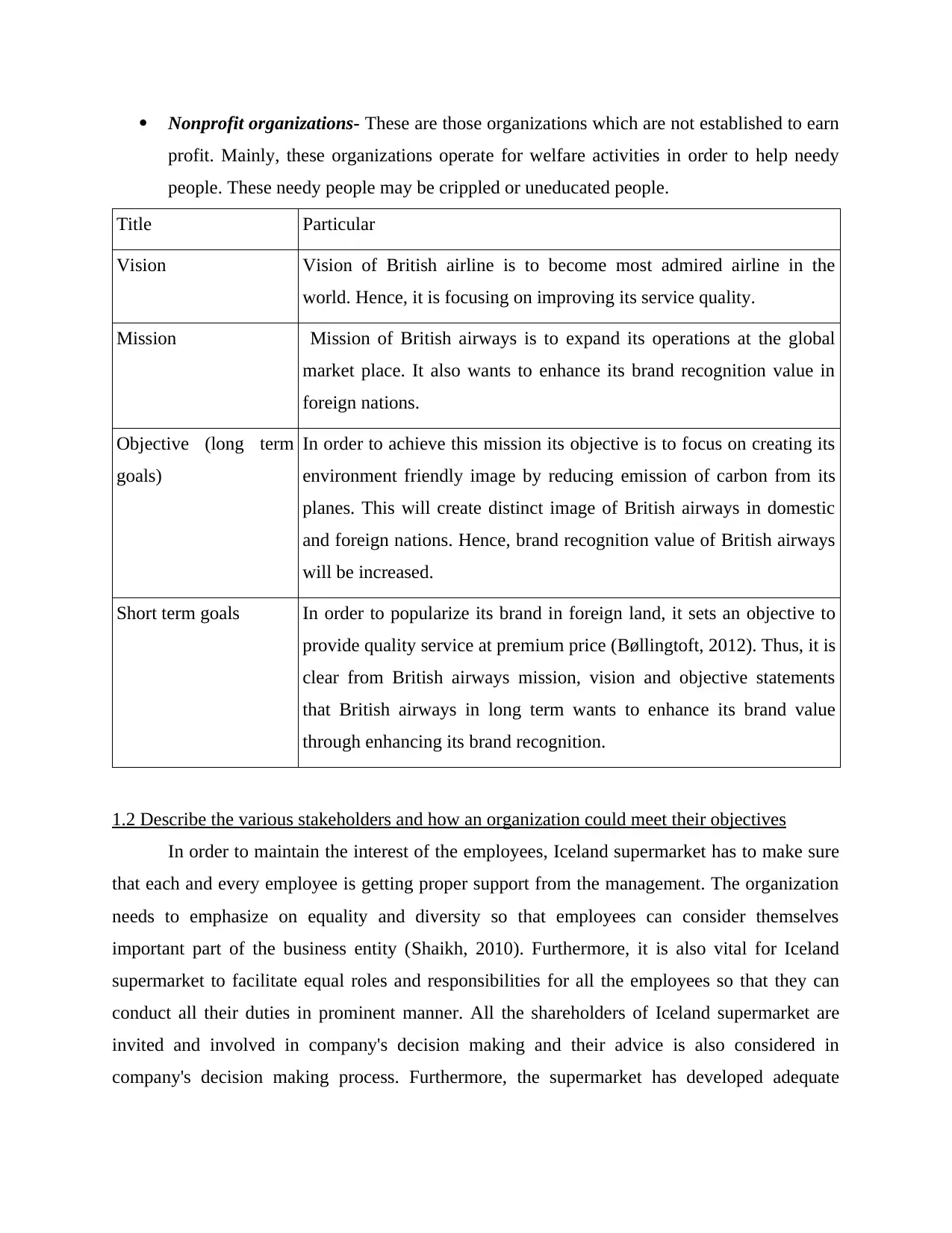
Nonprofit organizations- These are those organizations which are not established to earn
profit. Mainly, these organizations operate for welfare activities in order to help needy
people. These needy people may be crippled or uneducated people.
Title Particular
Vision Vision of British airline is to become most admired airline in the
world. Hence, it is focusing on improving its service quality.
Mission Mission of British airways is to expand its operations at the global
market place. It also wants to enhance its brand recognition value in
foreign nations.
Objective (long term
goals)
In order to achieve this mission its objective is to focus on creating its
environment friendly image by reducing emission of carbon from its
planes. This will create distinct image of British airways in domestic
and foreign nations. Hence, brand recognition value of British airways
will be increased.
Short term goals In order to popularize its brand in foreign land, it sets an objective to
provide quality service at premium price (Bøllingtoft, 2012). Thus, it is
clear from British airways mission, vision and objective statements
that British airways in long term wants to enhance its brand value
through enhancing its brand recognition.
1.2 Describe the various stakeholders and how an organization could meet their objectives
In order to maintain the interest of the employees, Iceland supermarket has to make sure
that each and every employee is getting proper support from the management. The organization
needs to emphasize on equality and diversity so that employees can consider themselves
important part of the business entity (Shaikh, 2010). Furthermore, it is also vital for Iceland
supermarket to facilitate equal roles and responsibilities for all the employees so that they can
conduct all their duties in prominent manner. All the shareholders of Iceland supermarket are
invited and involved in company's decision making and their advice is also considered in
company's decision making process. Furthermore, the supermarket has developed adequate
profit. Mainly, these organizations operate for welfare activities in order to help needy
people. These needy people may be crippled or uneducated people.
Title Particular
Vision Vision of British airline is to become most admired airline in the
world. Hence, it is focusing on improving its service quality.
Mission Mission of British airways is to expand its operations at the global
market place. It also wants to enhance its brand recognition value in
foreign nations.
Objective (long term
goals)
In order to achieve this mission its objective is to focus on creating its
environment friendly image by reducing emission of carbon from its
planes. This will create distinct image of British airways in domestic
and foreign nations. Hence, brand recognition value of British airways
will be increased.
Short term goals In order to popularize its brand in foreign land, it sets an objective to
provide quality service at premium price (Bøllingtoft, 2012). Thus, it is
clear from British airways mission, vision and objective statements
that British airways in long term wants to enhance its brand value
through enhancing its brand recognition.
1.2 Describe the various stakeholders and how an organization could meet their objectives
In order to maintain the interest of the employees, Iceland supermarket has to make sure
that each and every employee is getting proper support from the management. The organization
needs to emphasize on equality and diversity so that employees can consider themselves
important part of the business entity (Shaikh, 2010). Furthermore, it is also vital for Iceland
supermarket to facilitate equal roles and responsibilities for all the employees so that they can
conduct all their duties in prominent manner. All the shareholders of Iceland supermarket are
invited and involved in company's decision making and their advice is also considered in
company's decision making process. Furthermore, the supermarket has developed adequate
Paraphrase This Document
Need a fresh take? Get an instant paraphrase of this document with our AI Paraphraser
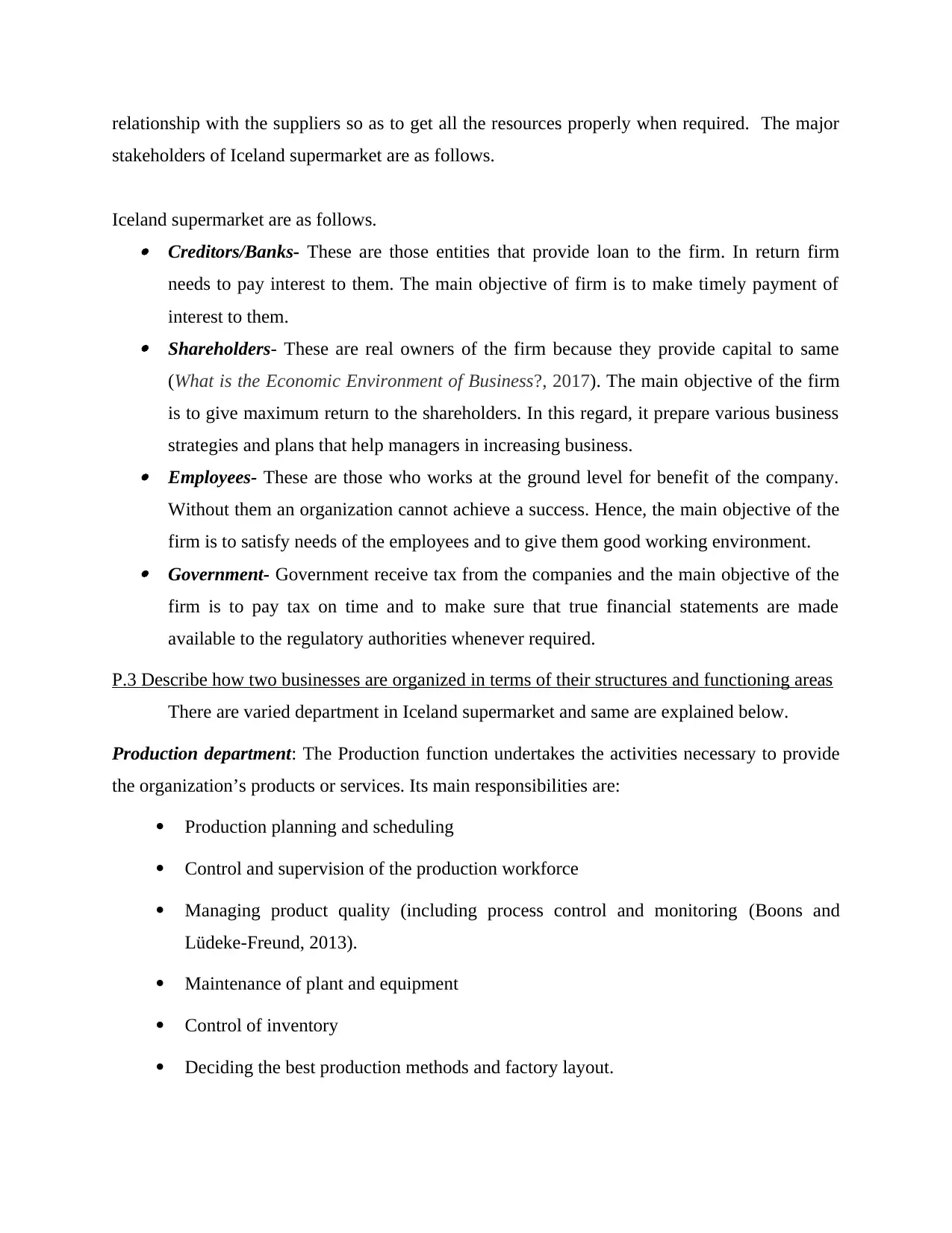
relationship with the suppliers so as to get all the resources properly when required. The major
stakeholders of Iceland supermarket are as follows.
Iceland supermarket are as follows. Creditors/Banks- These are those entities that provide loan to the firm. In return firm
needs to pay interest to them. The main objective of firm is to make timely payment of
interest to them. Shareholders- These are real owners of the firm because they provide capital to same
(What is the Economic Environment of Business?, 2017). The main objective of the firm
is to give maximum return to the shareholders. In this regard, it prepare various business
strategies and plans that help managers in increasing business. Employees- These are those who works at the ground level for benefit of the company.
Without them an organization cannot achieve a success. Hence, the main objective of the
firm is to satisfy needs of the employees and to give them good working environment. Government- Government receive tax from the companies and the main objective of the
firm is to pay tax on time and to make sure that true financial statements are made
available to the regulatory authorities whenever required.
P.3 Describe how two businesses are organized in terms of their structures and functioning areas
There are varied department in Iceland supermarket and same are explained below.
Production department: The Production function undertakes the activities necessary to provide
the organization’s products or services. Its main responsibilities are:
Production planning and scheduling
Control and supervision of the production workforce
Managing product quality (including process control and monitoring (Boons and
Lüdeke-Freund, 2013).
Maintenance of plant and equipment
Control of inventory
Deciding the best production methods and factory layout.
stakeholders of Iceland supermarket are as follows.
Iceland supermarket are as follows. Creditors/Banks- These are those entities that provide loan to the firm. In return firm
needs to pay interest to them. The main objective of firm is to make timely payment of
interest to them. Shareholders- These are real owners of the firm because they provide capital to same
(What is the Economic Environment of Business?, 2017). The main objective of the firm
is to give maximum return to the shareholders. In this regard, it prepare various business
strategies and plans that help managers in increasing business. Employees- These are those who works at the ground level for benefit of the company.
Without them an organization cannot achieve a success. Hence, the main objective of the
firm is to satisfy needs of the employees and to give them good working environment. Government- Government receive tax from the companies and the main objective of the
firm is to pay tax on time and to make sure that true financial statements are made
available to the regulatory authorities whenever required.
P.3 Describe how two businesses are organized in terms of their structures and functioning areas
There are varied department in Iceland supermarket and same are explained below.
Production department: The Production function undertakes the activities necessary to provide
the organization’s products or services. Its main responsibilities are:
Production planning and scheduling
Control and supervision of the production workforce
Managing product quality (including process control and monitoring (Boons and
Lüdeke-Freund, 2013).
Maintenance of plant and equipment
Control of inventory
Deciding the best production methods and factory layout.
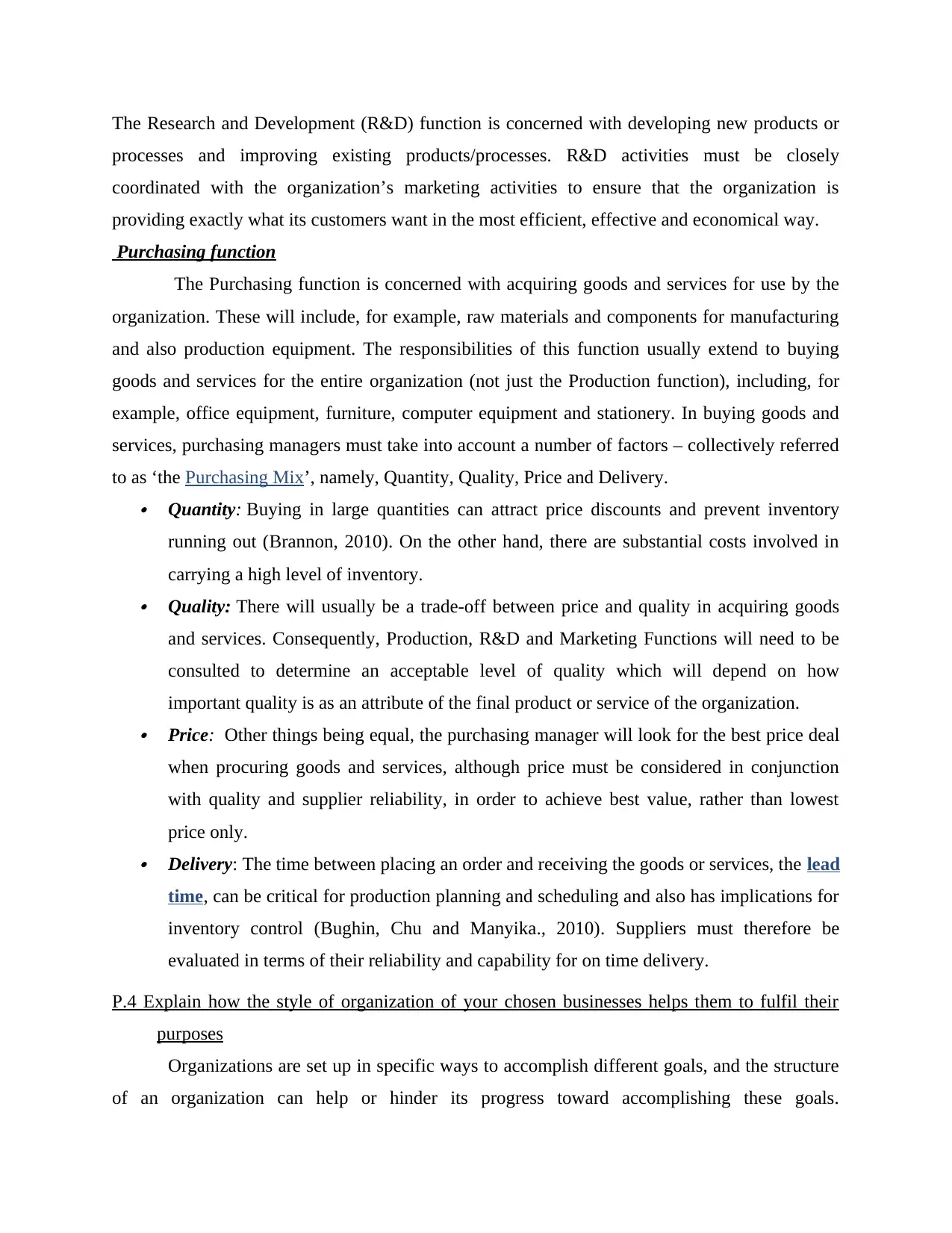
The Research and Development (R&D) function is concerned with developing new products or
processes and improving existing products/processes. R&D activities must be closely
coordinated with the organization’s marketing activities to ensure that the organization is
providing exactly what its customers want in the most efficient, effective and economical way.
Purchasing function
The Purchasing function is concerned with acquiring goods and services for use by the
organization. These will include, for example, raw materials and components for manufacturing
and also production equipment. The responsibilities of this function usually extend to buying
goods and services for the entire organization (not just the Production function), including, for
example, office equipment, furniture, computer equipment and stationery. In buying goods and
services, purchasing managers must take into account a number of factors – collectively referred
to as ‘the Purchasing Mix’, namely, Quantity, Quality, Price and Delivery. Quantity: Buying in large quantities can attract price discounts and prevent inventory
running out (Brannon, 2010). On the other hand, there are substantial costs involved in
carrying a high level of inventory. Quality: There will usually be a trade-off between price and quality in acquiring goods
and services. Consequently, Production, R&D and Marketing Functions will need to be
consulted to determine an acceptable level of quality which will depend on how
important quality is as an attribute of the final product or service of the organization. Price: Other things being equal, the purchasing manager will look for the best price deal
when procuring goods and services, although price must be considered in conjunction
with quality and supplier reliability, in order to achieve best value, rather than lowest
price only. Delivery: The time between placing an order and receiving the goods or services, the lead
time, can be critical for production planning and scheduling and also has implications for
inventory control (Bughin, Chu and Manyika., 2010). Suppliers must therefore be
evaluated in terms of their reliability and capability for on time delivery.
P.4 Explain how the style of organization of your chosen businesses helps them to fulfil their
purposes
Organizations are set up in specific ways to accomplish different goals, and the structure
of an organization can help or hinder its progress toward accomplishing these goals.
processes and improving existing products/processes. R&D activities must be closely
coordinated with the organization’s marketing activities to ensure that the organization is
providing exactly what its customers want in the most efficient, effective and economical way.
Purchasing function
The Purchasing function is concerned with acquiring goods and services for use by the
organization. These will include, for example, raw materials and components for manufacturing
and also production equipment. The responsibilities of this function usually extend to buying
goods and services for the entire organization (not just the Production function), including, for
example, office equipment, furniture, computer equipment and stationery. In buying goods and
services, purchasing managers must take into account a number of factors – collectively referred
to as ‘the Purchasing Mix’, namely, Quantity, Quality, Price and Delivery. Quantity: Buying in large quantities can attract price discounts and prevent inventory
running out (Brannon, 2010). On the other hand, there are substantial costs involved in
carrying a high level of inventory. Quality: There will usually be a trade-off between price and quality in acquiring goods
and services. Consequently, Production, R&D and Marketing Functions will need to be
consulted to determine an acceptable level of quality which will depend on how
important quality is as an attribute of the final product or service of the organization. Price: Other things being equal, the purchasing manager will look for the best price deal
when procuring goods and services, although price must be considered in conjunction
with quality and supplier reliability, in order to achieve best value, rather than lowest
price only. Delivery: The time between placing an order and receiving the goods or services, the lead
time, can be critical for production planning and scheduling and also has implications for
inventory control (Bughin, Chu and Manyika., 2010). Suppliers must therefore be
evaluated in terms of their reliability and capability for on time delivery.
P.4 Explain how the style of organization of your chosen businesses helps them to fulfil their
purposes
Organizations are set up in specific ways to accomplish different goals, and the structure
of an organization can help or hinder its progress toward accomplishing these goals.
⊘ This is a preview!⊘
Do you want full access?
Subscribe today to unlock all pages.

Trusted by 1+ million students worldwide
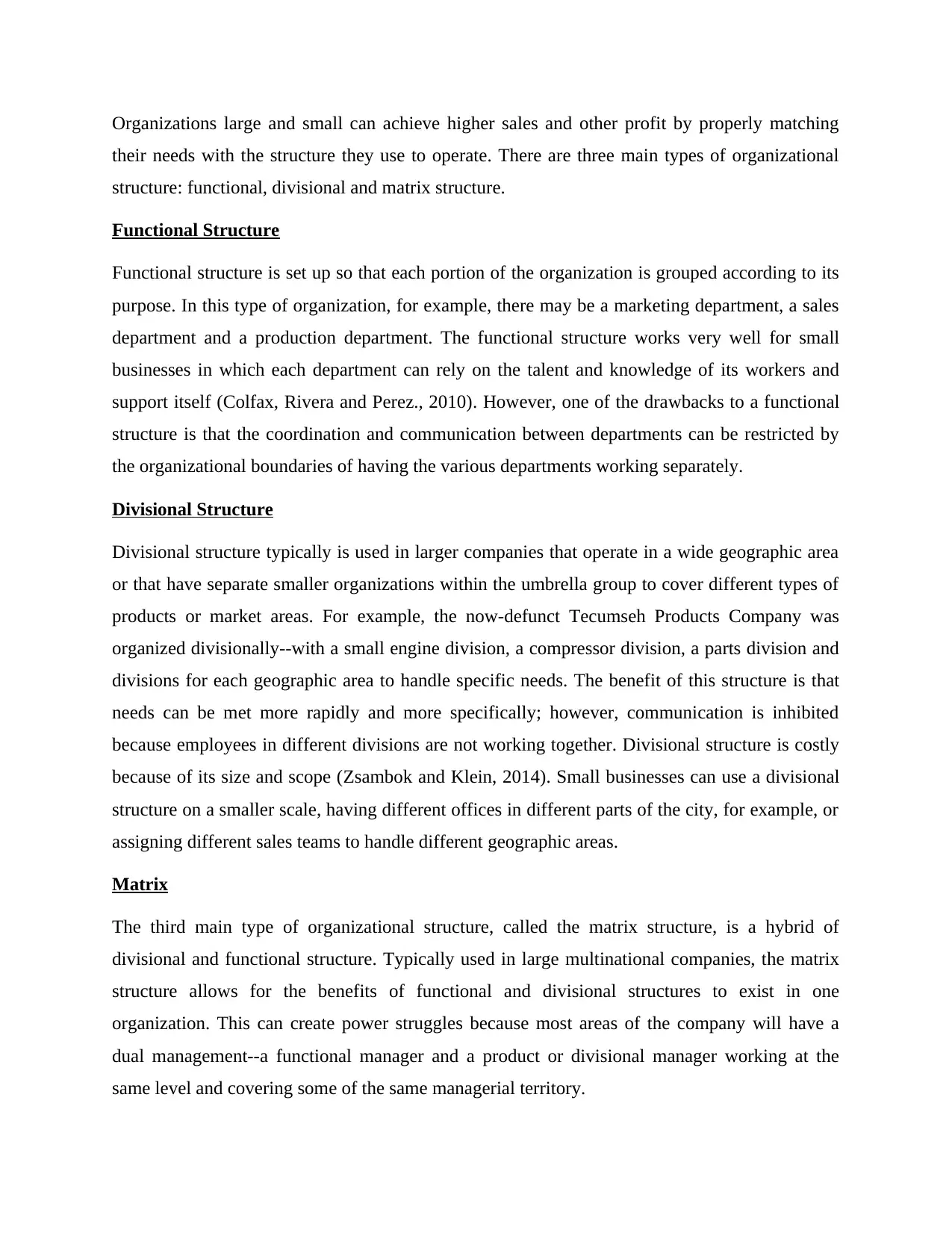
Organizations large and small can achieve higher sales and other profit by properly matching
their needs with the structure they use to operate. There are three main types of organizational
structure: functional, divisional and matrix structure.
Functional Structure
Functional structure is set up so that each portion of the organization is grouped according to its
purpose. In this type of organization, for example, there may be a marketing department, a sales
department and a production department. The functional structure works very well for small
businesses in which each department can rely on the talent and knowledge of its workers and
support itself (Colfax, Rivera and Perez., 2010). However, one of the drawbacks to a functional
structure is that the coordination and communication between departments can be restricted by
the organizational boundaries of having the various departments working separately.
Divisional Structure
Divisional structure typically is used in larger companies that operate in a wide geographic area
or that have separate smaller organizations within the umbrella group to cover different types of
products or market areas. For example, the now-defunct Tecumseh Products Company was
organized divisionally--with a small engine division, a compressor division, a parts division and
divisions for each geographic area to handle specific needs. The benefit of this structure is that
needs can be met more rapidly and more specifically; however, communication is inhibited
because employees in different divisions are not working together. Divisional structure is costly
because of its size and scope (Zsambok and Klein, 2014). Small businesses can use a divisional
structure on a smaller scale, having different offices in different parts of the city, for example, or
assigning different sales teams to handle different geographic areas.
Matrix
The third main type of organizational structure, called the matrix structure, is a hybrid of
divisional and functional structure. Typically used in large multinational companies, the matrix
structure allows for the benefits of functional and divisional structures to exist in one
organization. This can create power struggles because most areas of the company will have a
dual management--a functional manager and a product or divisional manager working at the
same level and covering some of the same managerial territory.
their needs with the structure they use to operate. There are three main types of organizational
structure: functional, divisional and matrix structure.
Functional Structure
Functional structure is set up so that each portion of the organization is grouped according to its
purpose. In this type of organization, for example, there may be a marketing department, a sales
department and a production department. The functional structure works very well for small
businesses in which each department can rely on the talent and knowledge of its workers and
support itself (Colfax, Rivera and Perez., 2010). However, one of the drawbacks to a functional
structure is that the coordination and communication between departments can be restricted by
the organizational boundaries of having the various departments working separately.
Divisional Structure
Divisional structure typically is used in larger companies that operate in a wide geographic area
or that have separate smaller organizations within the umbrella group to cover different types of
products or market areas. For example, the now-defunct Tecumseh Products Company was
organized divisionally--with a small engine division, a compressor division, a parts division and
divisions for each geographic area to handle specific needs. The benefit of this structure is that
needs can be met more rapidly and more specifically; however, communication is inhibited
because employees in different divisions are not working together. Divisional structure is costly
because of its size and scope (Zsambok and Klein, 2014). Small businesses can use a divisional
structure on a smaller scale, having different offices in different parts of the city, for example, or
assigning different sales teams to handle different geographic areas.
Matrix
The third main type of organizational structure, called the matrix structure, is a hybrid of
divisional and functional structure. Typically used in large multinational companies, the matrix
structure allows for the benefits of functional and divisional structures to exist in one
organization. This can create power struggles because most areas of the company will have a
dual management--a functional manager and a product or divisional manager working at the
same level and covering some of the same managerial territory.
Paraphrase This Document
Need a fresh take? Get an instant paraphrase of this document with our AI Paraphraser
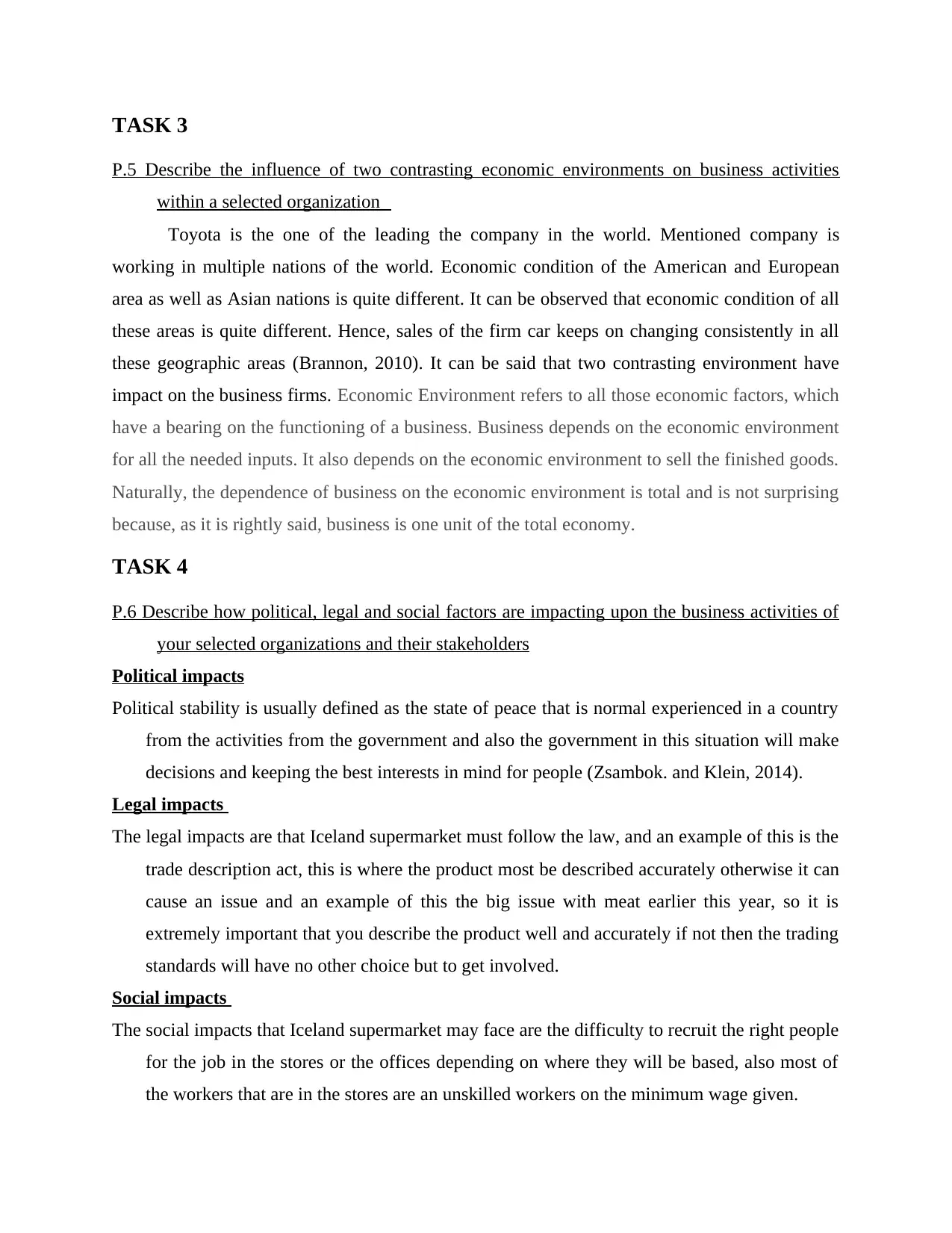
TASK 3
P.5 Describe the influence of two contrasting economic environments on business activities
within a selected organization
Toyota is the one of the leading the company in the world. Mentioned company is
working in multiple nations of the world. Economic condition of the American and European
area as well as Asian nations is quite different. It can be observed that economic condition of all
these areas is quite different. Hence, sales of the firm car keeps on changing consistently in all
these geographic areas (Brannon, 2010). It can be said that two contrasting environment have
impact on the business firms. Economic Environment refers to all those economic factors, which
have a bearing on the functioning of a business. Business depends on the economic environment
for all the needed inputs. It also depends on the economic environment to sell the finished goods.
Naturally, the dependence of business on the economic environment is total and is not surprising
because, as it is rightly said, business is one unit of the total economy.
TASK 4
P.6 Describe how political, legal and social factors are impacting upon the business activities of
your selected organizations and their stakeholders
Political impacts
Political stability is usually defined as the state of peace that is normal experienced in a country
from the activities from the government and also the government in this situation will make
decisions and keeping the best interests in mind for people (Zsambok. and Klein, 2014).
Legal impacts
The legal impacts are that Iceland supermarket must follow the law, and an example of this is the
trade description act, this is where the product most be described accurately otherwise it can
cause an issue and an example of this the big issue with meat earlier this year, so it is
extremely important that you describe the product well and accurately if not then the trading
standards will have no other choice but to get involved.
Social impacts
The social impacts that Iceland supermarket may face are the difficulty to recruit the right people
for the job in the stores or the offices depending on where they will be based, also most of
the workers that are in the stores are an unskilled workers on the minimum wage given.
P.5 Describe the influence of two contrasting economic environments on business activities
within a selected organization
Toyota is the one of the leading the company in the world. Mentioned company is
working in multiple nations of the world. Economic condition of the American and European
area as well as Asian nations is quite different. It can be observed that economic condition of all
these areas is quite different. Hence, sales of the firm car keeps on changing consistently in all
these geographic areas (Brannon, 2010). It can be said that two contrasting environment have
impact on the business firms. Economic Environment refers to all those economic factors, which
have a bearing on the functioning of a business. Business depends on the economic environment
for all the needed inputs. It also depends on the economic environment to sell the finished goods.
Naturally, the dependence of business on the economic environment is total and is not surprising
because, as it is rightly said, business is one unit of the total economy.
TASK 4
P.6 Describe how political, legal and social factors are impacting upon the business activities of
your selected organizations and their stakeholders
Political impacts
Political stability is usually defined as the state of peace that is normal experienced in a country
from the activities from the government and also the government in this situation will make
decisions and keeping the best interests in mind for people (Zsambok. and Klein, 2014).
Legal impacts
The legal impacts are that Iceland supermarket must follow the law, and an example of this is the
trade description act, this is where the product most be described accurately otherwise it can
cause an issue and an example of this the big issue with meat earlier this year, so it is
extremely important that you describe the product well and accurately if not then the trading
standards will have no other choice but to get involved.
Social impacts
The social impacts that Iceland supermarket may face are the difficulty to recruit the right people
for the job in the stores or the offices depending on where they will be based, also most of
the workers that are in the stores are an unskilled workers on the minimum wage given.
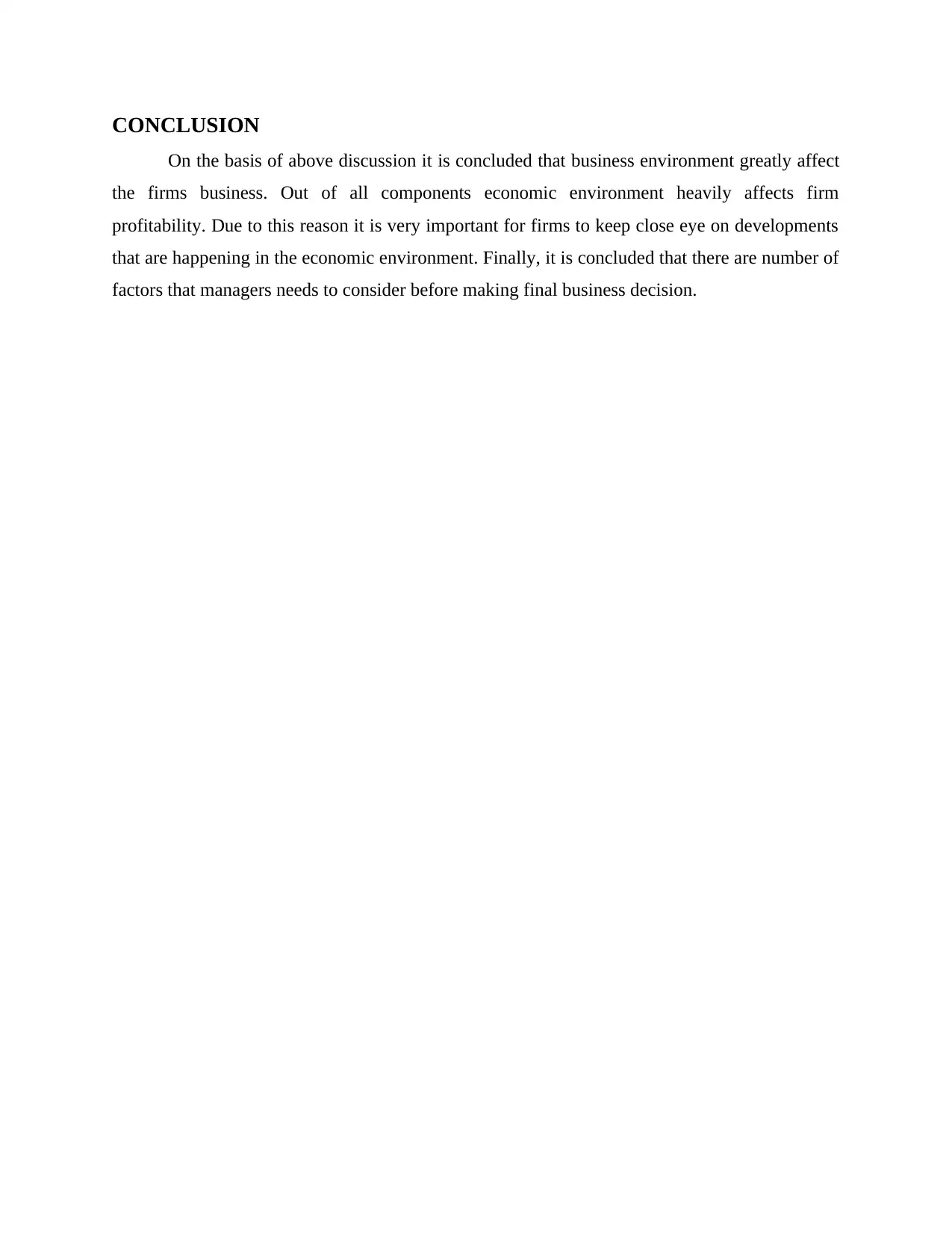
CONCLUSION
On the basis of above discussion it is concluded that business environment greatly affect
the firms business. Out of all components economic environment heavily affects firm
profitability. Due to this reason it is very important for firms to keep close eye on developments
that are happening in the economic environment. Finally, it is concluded that there are number of
factors that managers needs to consider before making final business decision.
On the basis of above discussion it is concluded that business environment greatly affect
the firms business. Out of all components economic environment heavily affects firm
profitability. Due to this reason it is very important for firms to keep close eye on developments
that are happening in the economic environment. Finally, it is concluded that there are number of
factors that managers needs to consider before making final business decision.
⊘ This is a preview!⊘
Do you want full access?
Subscribe today to unlock all pages.

Trusted by 1+ million students worldwide
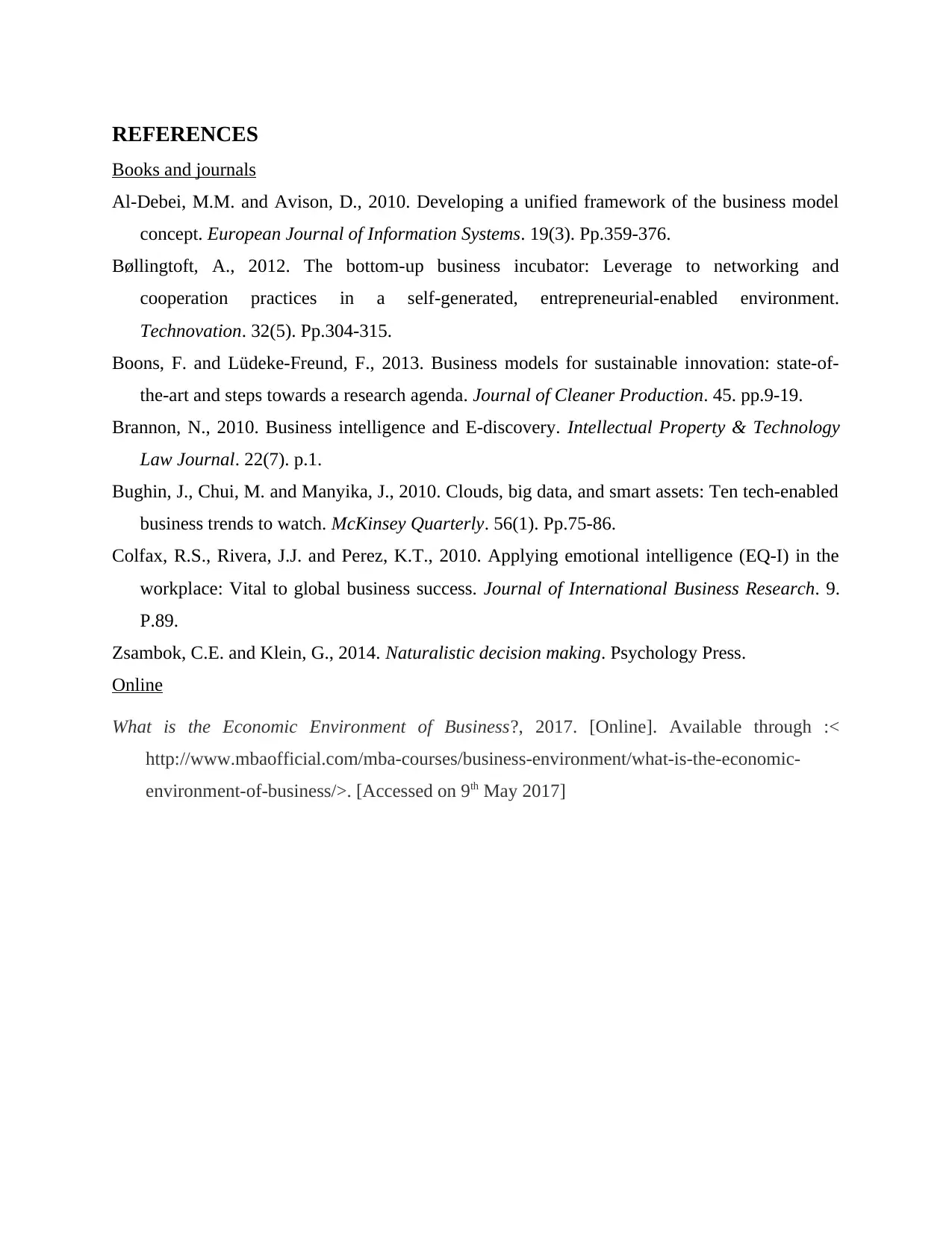
REFERENCES
Books and journals
Al-Debei, M.M. and Avison, D., 2010. Developing a unified framework of the business model
concept. European Journal of Information Systems. 19(3). Pp.359-376.
Bøllingtoft, A., 2012. The bottom-up business incubator: Leverage to networking and
cooperation practices in a self-generated, entrepreneurial-enabled environment.
Technovation. 32(5). Pp.304-315.
Boons, F. and Lüdeke-Freund, F., 2013. Business models for sustainable innovation: state-of-
the-art and steps towards a research agenda. Journal of Cleaner Production. 45. pp.9-19.
Brannon, N., 2010. Business intelligence and E-discovery. Intellectual Property & Technology
Law Journal. 22(7). p.1.
Bughin, J., Chui, M. and Manyika, J., 2010. Clouds, big data, and smart assets: Ten tech-enabled
business trends to watch. McKinsey Quarterly. 56(1). Pp.75-86.
Colfax, R.S., Rivera, J.J. and Perez, K.T., 2010. Applying emotional intelligence (EQ-I) in the
workplace: Vital to global business success. Journal of International Business Research. 9.
P.89.
Zsambok, C.E. and Klein, G., 2014. Naturalistic decision making. Psychology Press.
Online
What is the Economic Environment of Business?, 2017. [Online]. Available through :<
http://www.mbaofficial.com/mba-courses/business-environment/what-is-the-economic-
environment-of-business/>. [Accessed on 9th May 2017]
Books and journals
Al-Debei, M.M. and Avison, D., 2010. Developing a unified framework of the business model
concept. European Journal of Information Systems. 19(3). Pp.359-376.
Bøllingtoft, A., 2012. The bottom-up business incubator: Leverage to networking and
cooperation practices in a self-generated, entrepreneurial-enabled environment.
Technovation. 32(5). Pp.304-315.
Boons, F. and Lüdeke-Freund, F., 2013. Business models for sustainable innovation: state-of-
the-art and steps towards a research agenda. Journal of Cleaner Production. 45. pp.9-19.
Brannon, N., 2010. Business intelligence and E-discovery. Intellectual Property & Technology
Law Journal. 22(7). p.1.
Bughin, J., Chui, M. and Manyika, J., 2010. Clouds, big data, and smart assets: Ten tech-enabled
business trends to watch. McKinsey Quarterly. 56(1). Pp.75-86.
Colfax, R.S., Rivera, J.J. and Perez, K.T., 2010. Applying emotional intelligence (EQ-I) in the
workplace: Vital to global business success. Journal of International Business Research. 9.
P.89.
Zsambok, C.E. and Klein, G., 2014. Naturalistic decision making. Psychology Press.
Online
What is the Economic Environment of Business?, 2017. [Online]. Available through :<
http://www.mbaofficial.com/mba-courses/business-environment/what-is-the-economic-
environment-of-business/>. [Accessed on 9th May 2017]
1 out of 10
Related Documents
Your All-in-One AI-Powered Toolkit for Academic Success.
+13062052269
info@desklib.com
Available 24*7 on WhatsApp / Email
![[object Object]](/_next/static/media/star-bottom.7253800d.svg)
Unlock your academic potential
Copyright © 2020–2025 A2Z Services. All Rights Reserved. Developed and managed by ZUCOL.





